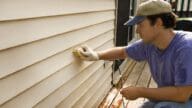How to Sell Your House in a Slow Market: 7 Mistakes to Avoid!
- Published on
- 5 min read
-
 Christine Bartsch, Contributing AuthorClose
Christine Bartsch, Contributing AuthorClose Christine Bartsch Contributing Author
Christine Bartsch Contributing AuthorFormer art and design instructor Christine Bartsch holds an MFA in creative writing from Spalding University. Launching her writing career in 2007, Christine has crafted interior design content for companies including USA Today and Houzz.
-
 Sam Dadofalza, Associate EditorClose
Sam Dadofalza, Associate EditorClose Sam Dadofalza Associate Editor
Sam Dadofalza Associate EditorSam Dadofalza is an associate editor at HomeLight, where she crafts insightful stories to guide homebuyers and sellers through the intricacies of real estate transactions. She has previously contributed to digital marketing firms and online business publications, honing her skills in creating engaging and informative content.
For-sale signs have taken over your block, the local jobs market doesn’t look great, and big red price reduction labels tarnish most of the online home listings in your area. You’ve got enough evidence to conclude that you’re in a slow real estate market and the odds aren’t in your favor when you sell your house.
Given that we have no control over the state of the economy or the pace of home sales, you’ll need to channel your competitive side and think of this as your next challenge. Even in sluggish markets, houses still sell. Achieve a successful home sale with the right game plan and avoids these common mistakes.
Mistake #1: Minimal house prep
Selling your house in a slow market is not for the hasty or lazy. You’ll need to put in some sweat equity to prepare the house and bring it to stellar condition.
“Not prepping the house inside and out is number one home sellers make — especially in a slow market,” says Lex Lianos, a Northern Virginia agent who’s sold 83% more properties in the area than his peers.
“You need to clean, declutter and stage your home or your dooming your sale from the start.”
No matter which type of market you’re facing, you’ll need to deep clean and declutter to meet the bare minimum buyer expectations. However, in a buyer’s market, don’t be surprised if you have to go beyond that to tackle a handful of repairs and upgrades to make your home’s desirability rise above the competition.
Here’s what you need to tackle:
- Declutter and deep clean: A messy, dirty house screams neglect. Clear out unnecessary items and scrub every room top to bottom to make your home feel fresh and spacious.
- Maintain the yard: First impressions matter, and a neglected yard can turn buyers away before they even step inside. Stage your outdoor space properly to attract buyers. Keep the lawn trimmed, remove weeds, and plant some flowers for a welcoming touch.
- Clean or replace carpets: Stained or worn-out carpets make a home feel old. Get them professionally cleaned or install new ones for a more polished look.
- Paint the interior: A fresh coat of neutral-colored paint brightens up rooms and makes the space feel move-in ready. Avoid bold colors that might not appeal to buyers.
- Remove dirt and cobwebs from the entrance: A dusty, cobweb-filled entryway gives the impression that the home hasn’t been maintained. Wipe down doors, windows, and light fixtures to create a more inviting entrance.
- Trim trees and add fresh mulch: Overgrown trees can make a property look neglected, and fresh mulch instantly makes flower beds pop. A little effort in the yard goes a long way in boosting curb appeal.
- Paint the exterior: A dull, peeling exterior makes buyers assume the home is in poor shape. A fresh coat of paint modernizes the look and signals that the home has been well cared for.
A staged home not only sells faster than an unstaged one but can also command a higher price. By highlighting the home’s best features and creating a welcoming atmosphere, staging helps buyers emotionally connect to the space. It also makes the property look more move-in ready, reducing buyer hesitation. Plus, homes that present well in photos and showings tend to attract more interest, leading to quicker sales and stronger offers.
Staging your home doesn’t have to drain your wallet. Read our guide on Staging a House on a Budget to Wow Buyers for affordable tips to make a lasting impression.
Mistake #2: Maintenance neglect
You don’t need to drop a giant wad of cash on improvements that’ll cost more than they add in value, like a full kitchen or bathroom renovation. But in a slow market, you should deal with any deferred maintenance you’ve put off over the course of ownership, whether it be leaky plumbing, a wobbly ceiling fan, or a mold issue in the basement.
- First, make a list of any known issues with the house. You live there, so you should have a good idea of what’s in good shape and what’s not.
- Then, have your agent do a walkthrough with fresh eyes to check for problems like peeling paint, dents in the wall, or cracked tiles you may have missed or forgotten about.
- Next, book the appropriate contractors to come out and deal with the issues at hand.
Save money and hire out all of your little odd jobs to a handyman who can patch a knocked or damaged drywall and secure a loose toilet seat in one visit. Bigger projects like roof repairs, electrical work, and pest control will require a specialty tradesperson. Every repair you make must be up to code, or you’ll face delays when the home inspector comes through later down the line.
In a slow market, you’ll reduce hassles and increase your chances of securing an offer if you take care of outstanding maintenance yourself. But if you don’t have the upfront funds to take care of necessary repairs, you’ll have to disclose any known material defects per your state’s laws and then compensate for the issue with an appropriate pricing strategy.
Mistake #3: Amateur photography
In today’s digital era, where 43% of homebuyers begin their search online, it’s critical that your listing photos be on point. 41% of buyers say they find photos to be very useful.
While it’s possible to take great listing photos yourself if you know what you’re doing, in a buyer’s market, it’s not worth the risk—especially when hiring a professional real estate photographer will only cost you an average of $200 to $400. That’s a cheap way to get a leg up on your competition.
Hiring a pro doesn’t mean you’re completely off the hook, though. You’ll still have plenty of work on your plate to stage and prep your home for its photoshoot.
Mistake #4: Overpricing
When retailers get stuck with inventory, they lower the price until it finally moves out the door, even if that means selling it at a loss.
This works for retailers who have loads of products waiting in the wings for shelf space that can be sold at a premium price. But for home sellers, you’ve only got one product, so you can’t afford to discount if the property doesn’t sell.
“It’s literally the kiss of death if you overprice even by a percent or two, but sellers always think that their house is worth more than it is,” says Liano.
Overpricing can hamper your sale in any market condition, but in a buyer’s market, it can completely kill your chances of selling. So don’t make the mistake of simply listing at the same price or higher than recent comps have sold for. Listen to your agent and look at the data to find the right list price to help your home sell fast even in a competitive market.
Mistake #5: Mediocre marketing
Great photos and the right price can only go so far in selling your house—if no one knows about your listing.
While it may be tempting to cut costs on your marketing budget to offset the fact that it could take months for your house to sell, reducing your marketing efforts will only prolong your days on the market.
“Selling in a slow market isn’t easy, so putting your property in front of as many buyers as possible is key,” explains Lianos.
“Boosted Facebook ads, blog posts, email blasts to buyer brokers. It’s that type of exposure that’ll sell your home in a slow market.”
Unless you’re selling your own home, the marketing plan for selling your home is in your agent’s hands. But that doesn’t mean you can’t help pick the listing photos, confer about the listing descriptions, and strategize over the marketing timeline.
How an agent handles the marketing for their listings is also one of the big questions you should ask before hiring an agent. If yours doesn’t have great answers to your marketing questions, it’s probably time to hire an agent with a proven track record.
Mistake #6: Restricting buyers’ access to your home
No one likes to be told to get out of their own home, but that’s what you’ll need to put up with while your home is on the market.
Develop a showings strategy that includes quick and easy cleaning wipes, portable bathroom caddies, and lidded storage bins, so that you can quickly clean and hide away your toiletries and personal items on just an hour’s notice.
Don’t make it difficult for buyers to view your home by refusing a lockbox or setting excessive restrictions, like requiring half a day’s notice for showings. The easier it is to access, the more potential buyers you’ll attract.
Mistake #7: Stubborn negotiations
Even once you’ve received and accepted a decent offer in a competitive buyer’s market, you’ll need to get through the buyer’s home inspection and the back-and-forth on repair requests.
“In a slow market, buyers are picky, and finicky, and not as committed to the home sale as the seller. They’ll walk away over the smallest things because they know there are plenty of other properties out there,” says Lianos.
“So, I highly recommend to my sellers that they do every ridiculous request on the inspection list. Sellers need to accommodate because the standing firm will lose you the buyer. And it’s going to cost you tens of thousands of dollars more to relist and have it sitting on the market for months than doing that $2,000 repair.”
Buyer brokers know that most relisted properties are a huge red flag, signaling that there’s either something wrong with the house itself or the sellers are difficult to work with.
Savvy sellers know that fulfilling any after-inspection requests from their buyers will actually save them money in the long run—as long as they’re at least semi-reasonable.
No need to spend $3,000 on a hot tub just because your buyers want one, but be prepared to pay for a home warranty or provide other buyer incentives, like a closing cost credit buying down their interest rate.
Selling in a slow market: Have professional help on your side
If life were a fairytale, you sell your house whenever you want and at the price you want. In real life, sellers are at the mercy of the market.
Plus, every house is different. What it takes to sell your house in a slow market could be different than your neighbor’s situation. When in doubt, work with a top local real estate agent with experience in your area and property type to navigate tough decisions. A professional could be the one to save you from spending tens of thousands on a roof replacement when all it needed was a partial repair.
Header Image Source: (Clay Elliot / Pexels)








